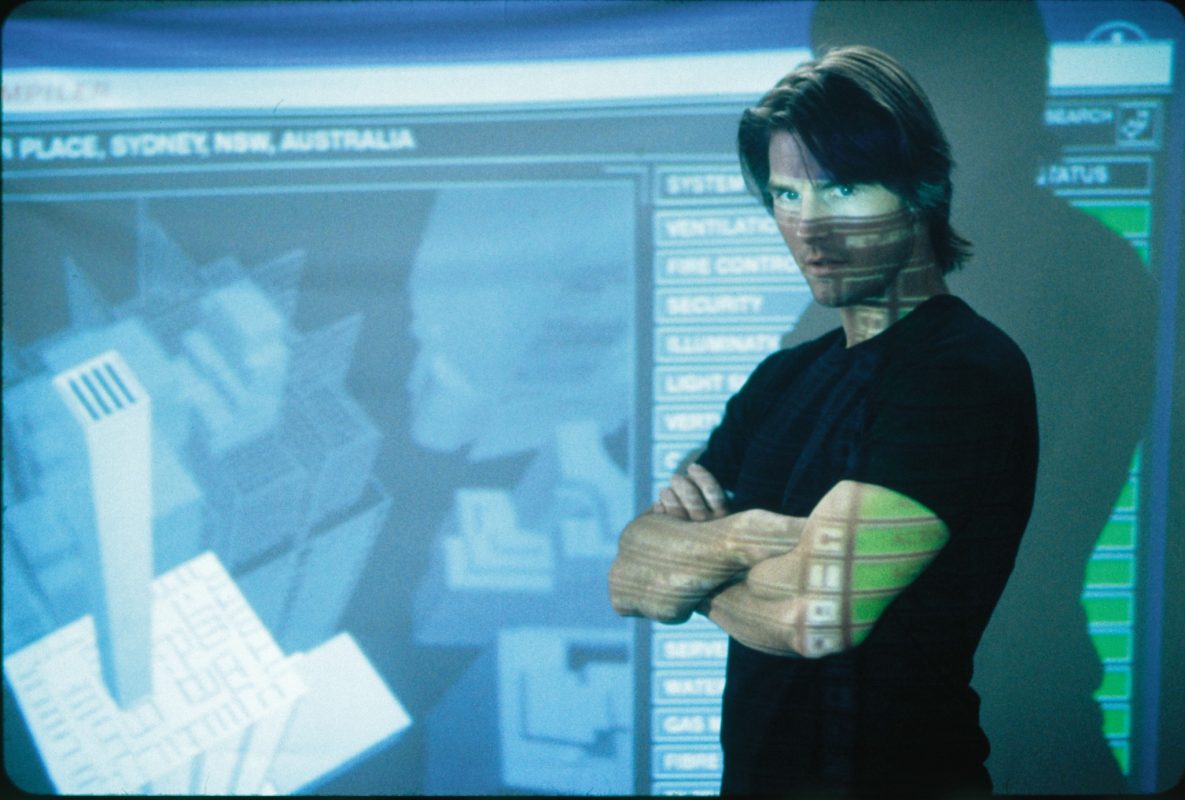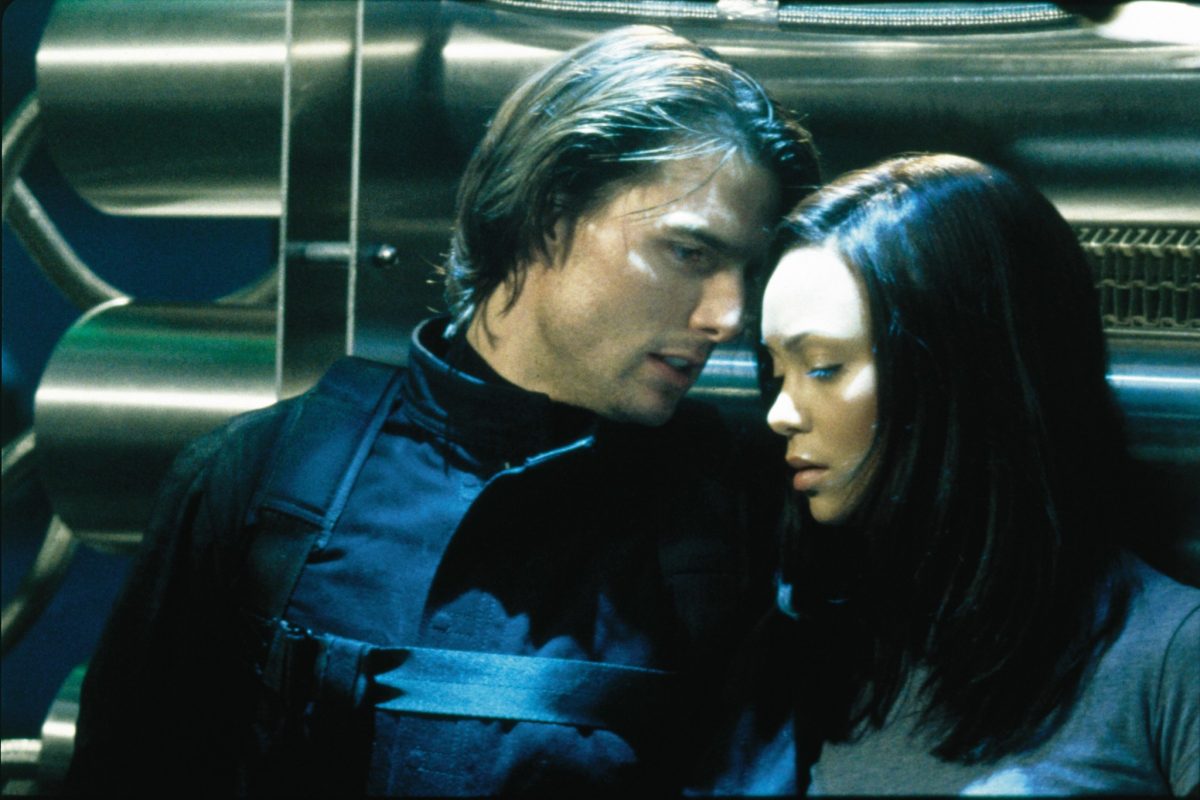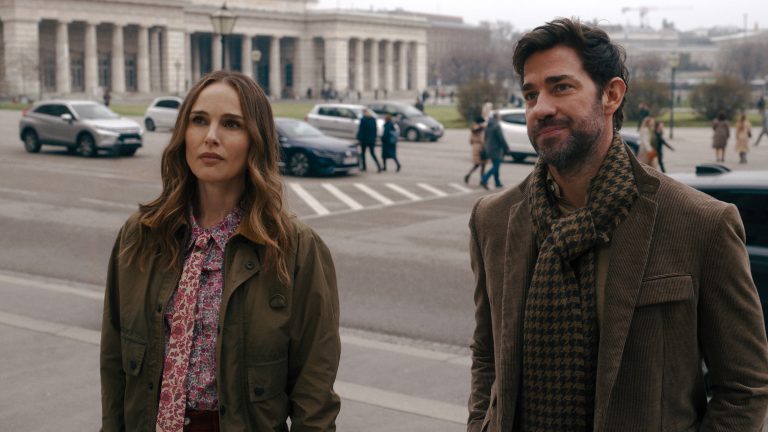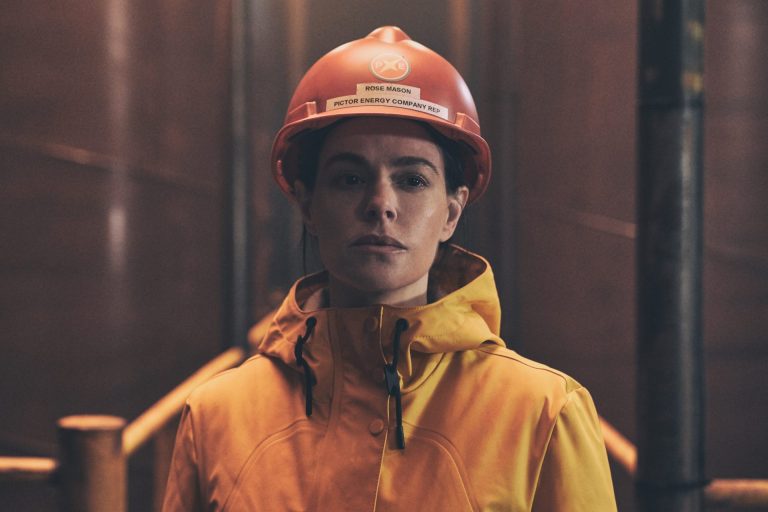A simple Wikipedia search tells us “Mission: Impossible 2,” directed by John Woo and scripted by the late Robert Towne, met with mixed critical reception—”praise for the action sequences and Woo’s direction, but criticism for the characterization.” In retrospect, that summary barely scratches the surface. For a Hong Kong auteur with an unabashed fondness for balletic shootouts and stylized violence, Woo’s storytelling here feels surprisingly sultry—even seductive—for something so allegedly threadbare.
The film pulses with erotic tension, bio-warfare paranoia, and the thinnest layer of political intrigue. And for a sequel dead-set on going bigger than its predecessor while revving up the franchise engine, it mostly delivers. The aesthetics and production design are lush. Even when the “lesser sequel” energy kicks in, particularly during Ethan’s lab heist to destroy the virus, the visual payoff remains satisfyingly sleek. Not to mention the greatest of all Tom Cruise hair eras: that windswept, slow-mo glory gets its own kind of billing.
What doesn’t work, however, is ironically what the film leans on most: the action. The car chases are thrilling, and several face-offs come unhinged in all the right ways. But the relentless downpour of slow-motion flourishes—both physical and emotional—cracks under the weight of its own overuse. The momentum gets bogged down. The choreography, meant to thrill, ends up feeling ornamental. And the entire lead-up to the climax drags the film’s confidence through the dirt, making even the brightest stars feel like they’re flickering out. Still, this descent into mediocrity can’t rob the film of one thing: its pulse. This is a genre piece that breathes cinema through its pores. And thanks to its place in a franchise that would only grow more beloved with time, “M:I-2” remains etched—if not exalted—in the discourse of both spy and action cinema.
The jargon, though, can get dizzying if you’re not mentally noting who turned into Ethan Hunt and who Ethan Hunt turned into. So, for those leaning on the power of narrative clarity, here’s our attempt at deconstructing “Mission: Impossible 2” (2000) for you.
Mission: Impossible II (2000) Plot Summary and Synopsis:
How does the Chimera virus first come into play?
Before the title card appears, we see biogenetics scientist Dr. Vladimir Nekhorvich working in a lab in Sydney. He sends a message to the IMF addressed to his old friend Dimitri—Ethan Hunt’s cover name—warning that his employer, Biocyte Pharmaceuticals, has coerced him into developing a biological weapon called the Chimera virus to profit from its cure, Bellerophon. He tells him he must reach Atlanta within 20 hours of leaving Australia. However, during the flight to Atlanta, IMF agent Sean Ambrose—disguised as Dimitri—goes rogue. Betraying Nekhorvich, he gasses everyone aboard, steals Bellerophon, and parachutes out with his associates before the plane crashes into the Rockies.
How is Nyah introduced?
Meanwhile, in Seville, Ethan undertakes a dangerous solo trek to the top of a cliff, where he receives a message from IMF director Swanbeck. Swanbeck tasks him with recovering Chimera and Bellerophon and instructs him to recruit Nyah Nordoff-Hall, a civilian who works as a professional thief. They meet at a Spanish ballroom party, where Ethan serves as security. They share a charged meet-cute, and Ethan helps her steal a necklace near a bathtub—only for her to be caught red-handed. Ethan then chases her in his car, and the tension between them culminates in them making love.
Later, during the Spanish Fallas festival, Ethan meets Swanbeck in person. Swanbeck tells him everything that transpired during his leave—how Ambrose, sent in Ethan’s stead and disguised as him, betrayed them. He reveals the real reason behind recruiting Nyah: not her theft skills, but her past relationship with Ambrose. They want her to track him. When Ethan protests the difficulty, Swanbeck retorts that this is Mission: Impossible, not Mission: Difficult, and that “difficult should be a walk in the park” for him.
How does Nyah manage to re-enter Ambrose’s life?
Despite her initial reluctance, Ethan persuades Nyah to trace Ambrose in Sydney using an injectable tracking device. Ethan assembles his team—old friend and hacker Luther Stickell, and helicopter pilot Billy Baird. In Sydney, Nyah pretends to rekindle her relationship with Ambrose, convincing him of her renewed interest. Hugh Stamp, Ambrose’s right-hand man, remains suspicious of her return. Irritated by his doubt, Ambrose slices off part of Hugh’s finger and dismisses him with, “Some of us have the burden of sex to deal with.”
Nyah manages to reconnect with Ethan during a horse-racing event she attends with Ambrose. Around this time, Ambrose uses video footage of Chimera infecting one of Nekhorvich’s colleagues to blackmail Biocyte CEO John McCloy into cooperating. Nyah delivers the memory card to Ethan, revealing that Chimera has a 20-hour dormant period and that Bellerophon is only effective within that window. Ambrose realizes Nyah stole the envelope from his left jacket pocket when she returns it to the right one by mistake.
What happens to McCloy after Ambrose threatens him?
Meanwhile, McCloy is en route home in his car when he sees a fake news report announcing his death by Chimera. Alarmed, he asks the driver to roll down the window, only to be incapacitated by the chauffeur, who turns out to be part of the IMF’s plan. McCloy regains consciousness in a hospital and is shocked to see Nekhorvich, long presumed dead. But it’s actually Ethan in disguise. Through McCloy, Ethan learns that all Bellerophon samples taken by Nekhorvich are now in Ambrose’s possession, but the virus remains inaccessible—Nekhorvich had injected it into himself.
Mission: Impossible II (2000) Movie Ending Explained:
How is Nyah exposed, and what does she do to stop Ambrose?
Later that night, Ambrose disguises himself as Ethan to test Nyah’s loyalty. When she seems to follow “Ethan’s” instructions, Ambrose confirms her betrayal. Ethan breaks into Biocyte headquarters and destroys two Chimera samples, but Ambrose and his men intercept him, having discovered Nyah’s duplicity. At a standstill, Ambrose orders Nyah to hand over the final sample. Instead, she injects herself with it and begs Ethan to kill her, thereby destroying the virus. Ethan refuses and escapes the facility, promising to get her the Bellerophon within 19 hours. Ambrose, determined to unleash the virus, sets Nyah loose to wander the streets of Sydney.
Also Read: 10 Best Action Sequences from the Mission: Impossible Franchise
How does the final confrontation with Ambrose play out?
At Biocyte’s storage facility on Bare Island, Ambrose offers to sell Bellerophon to McCloy in exchange for enough stock options to become Biocyte’s majority shareholder, ensuring billions for them both. Ethan infiltrates the island base and defeats Hugh Stamp in a brutal fight. Stamp, seemingly having captured Ethan, brings him before Ambrose, who shoots him dead. But Ambrose notices the bandaged finger on the corpse—one he had earlier cut—and realizes he’s killed Stamp, masked and gagged. The real Ethan has already made off with the Bellerophon samples.
Enraged, Ambrose chases Ethan onto the mainland. Ethan kills Ambrose’s men, while Luther and Billy locate Nyah, who is on the verge of suicide, to stop the spread of the virus. Ethan and Ambrose engage in a brutal fistfight on the beach, ending with Ethan killing him. He rushes to deliver Bellerophon to Luther, who injects Nyah just in time. The IMF clears Nyah’s criminal record, and Ethan begins a quiet vacation with her in Sydney.
Mission: Impossible II (2000) Movie Themes Explained:
Infection, Intimacy, and Control
Say what you will about the inherent mediocrity of “Mission: Impossible 2″—its watered-down action palette, its glossy overreliance on slow-mo posturing—but it drips with a kind of steamy sexiness that was entirely absent from the first film. Robert Towne’s script weaponizes bodily proximity, turning the sweaty dance of espionage into something erotically charged, almost lurid in its fixation. This obsession with bodies—touching, mimicking, betraying—doesn’t just animate the action but sits at the heart of the premise, which hinges on a virus and its cure: Chimera and Bellerophon. These aren’t just biochemical agents; they’re the metaphoric flesh of the film, the very stakes of affection, seduction, and loyalty.

The elaborate masquerade of love, lust, and betrayal revolves around them. And while the romance between Ethan and Nyah may feel theatrically choreographed, even superficial, it’s clear what’s being staged here. The physicality is explicit, the sensuality indulgent. Nyah isn’t swept away by a cause—she’s heady from Ethan’s touch. That pleasure, almost narcotic in its pull, becomes her entry point into a twisted, high-stakes game of subterfuge. The film doesn’t romanticize their bond as much as it eroticizes it. Love here is less about emotional stakes and more about how far your body will go, for whom, and at what cost.
And while this may seem like over-reading a largely straightforward narrative, Nyah’s decision to inject herself with the virus isn’t just a selfless act—it’s erotically defiant. In a world where she’s constantly being used, lied to, and maneuvered by Ambrose and also by Hunt, this is her moment of power. It’s a form of bodily assertion, a reclaiming of agency through contamination. It’s also intimate: her death becomes something only Ethan can prevent, locking them into a fatal intimacy timed to a 20-hour countdown. Meanwhile, Sean’s jealousy is mapped directly onto Chimera’s arc of infection. His manipulations—of language, identity, even appearance—are already contagious. The virus simply literalizes his most dangerous quality: the ability to corrupt everything he touches.
Capitalism and Biopower
Beneath all the aerial stunts, beach-duels, and operatic slow-mo lies Mission: Impossible 2’s most coherent and unspoken horror: that the world is run by men who treat life, death, and cure as commodities in a boardroom. Biocyte Pharmaceuticals isn’t just another evil corporation—it’s a grotesque mirror of late-capitalist logic. It engineers a virus with the sole purpose of profiting from its cure. Death becomes a business model. Ethics becomes optional. And the one man who’s supposedly in charge of this—John McCloy—reacts not with guilt or urgency, but with alarm over a fake obituary. His public image matters more than the actual threat of global infection.
Ambrose, meanwhile, isn’t trying to unleash destruction for ideology. He wants shares. His whole plan revolves around acquiring enough stock to become the majority stakeholder. He’s not a terrorist—he’s a hostile investor with a biochemical pitch. This is what makes his evil terrifyingly mundane: he’s figured out how to turn pandemic into portfolio growth. In that, he’s not an anomaly but a natural product of the same system that created Biocyte.
What “Mission: Impossible 2” (2000) leaves hanging—but can’t entirely hide—is the absurd cruelty of a world where private corporations can manufacture both a disease and its salvation, choosing who gets access based not on need but profit margins. The virus is just a tool; the real weapon is ownership. It’s McCloy’s smug detachment, Ambrose’s greed, and the IMF’s morally grey interventions that create a closed circuit where human life is constantly being weighed, priced, and exchanged.








